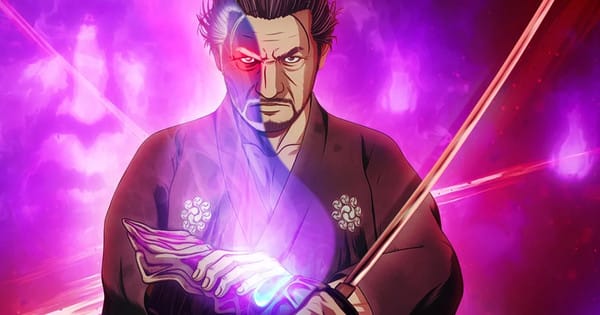
Onimusha Anime Collection Overview
Onimusha is a better-than-average anime adaptation of a video game property but doesn’t leave much lasting impact.
I’m decidedly in the middle of the road regarding this adaptation. By way of background, I’m only passingly familiar with the Onimusha games. I remember playing a demo disc at one point and watching a friend play a bit of the first game when it was still new. At the time, it struck me as a cool alternate setting for a Resident Evil-style game – whether or not that was a fair assessment, I’m not entirely sure. I liked the overall look and vibe of the setting, and at the time, the idea of a video game where you played a samurai fighting supernatural monsters seemed original and fresh to my mind. I vaguely kept tabs on releases over the years (particularly when I worked at a video game retailer) and got a big kick out of seeing famous actors like Jean Reno on the box art.
Despite all this, I never really played the titles or had more than the limited experience I had gleaned from short play sessions. Lore-wise, I’m basically brand new to the franchise. Sometimes, this can be an advantage for watching an anime adaptation as it can help ease newcomers into the series; other times, this can be a disadvantage as the anime might only appeal to true die-hard fans. I’m unclear whether Onimusha was intended to appeal to those who already are huge fans, but I can at least weigh how it felt as an introduction.
The creative backing certainly had me intrigued going in, if nothing else. I’m unfamiliar with Sublimation‘s work, but have seen a few other CG-animated Netflix productions. At only eight episodes, I assumed the shorter length might give the team time to focus more on important scenes and excel where most other CG productions struggle (in my estimation, anyway). It is also directed by none other than Takashi Miike, a director whose work I mostly know from feature-length films. I’ve seen a fair clutch of his cinematic work, and it runs the gamut in style, tone, and motifs. Even if I don’t enjoy the final product sometimes, he has an interesting approach that makes it worth experiencing.
On the surface, the series retains the qualities that I already associated with it. This tale follows Miyamoto Musashi – a historical figure of such notoriety that he needs no introduction – on a journey to slay demons in the countryside. His likeness is fashioned after the iconic actor Toshirō Mifune. He is joined by a small group of fellow travelers – warriors, a monk, a small orphan child, etc – and faces off against monstrous forces as he learns more about a strange and mighty gauntlet. This gauntlet grants him heightened abilities at a terrible cost while the mysteries of what happened in the area regarding hidden gold and dark experiments unfold.
First off, let’s hit the positives. Even at its worst moments, the show looks just fine, yet it excels in the action sequences. The slower scenes don’t do much to excite visually, but they never veer into the outright hideous territory some CG shows end up in. Any scenes with characters conversing end up flat and wooden, but it’s nothing egregious. Meanwhile, the action sequences pop and have a high degree of fluid motion and excitement. The choreography isn’t intricate, though great visuals and excellent cinematography offset that. Whenever someone draws a sword to start cutting demons, it’s about to be a good time, and that’s a rather common event.
There’s also no real stumbles or missing elements to speak of. There’s a solid enough cast that each gets at least a brief bit of backstory or motivation during the journey. Each episode features at least one or two big revelations or insights for the cast as they travel, and the dialogue feels natural between them. It’s never bogged down too much in lore or moral grandstanding, focusing instead on the forward moment and getting to the next action sequence. It keeps the show moving at a nice, steady pace throughout.
The downside is that there isn’t that much meat on the bones. There’s a rather large cast for how short the series is, with about 6-8 heroes at various points, plus the villains. The show tries to give each character some time to shine but then often follows that with a dramatic sacrifice immediately afterward. This gives the proceedings a revolving door feeling, where each episode introduces just a bit more about a character before giving them the boot. It’s nice that they all get attention somehow, but with so little time and focus on each character, it is hard to feel attached to any of them. After only a few episodes, a very cynical rhythm robs the series of what little mystery it had to begin with.
There’s also a lot of pressure and expectation on the series, which are the consequences of the modern anime environment. In the early 2000s, the concept of samurai fighting the supernatural seemed relatively novel to my younger self. There were similarish works I had been exposed to (Ninja Scroll comes to mind), but not much. In 2023, the concept seems far less fresh than it did back then. Recent works like Demon Slayer and the Dororo remake are running around in the same space with sky-high production values and playing with similar premises and themes. Without the shine of novelty, it’s easier to be more critical of the execution.
Furthermore, it’s unclear to me how the Onimusha setting is substantially different from these other works playing in the same space. The world is not explored in great detail, and most characters have simple motivations or meet rather definitive ends – yet another consequence of only having eight episodes to work with. In these constraints, it’s hard to leave much of a lasting impression other than, “Well, it had some cool fight scenes.” Even the fight scenes are stacked against some stiff competition, which isn’t a knock against Onimusha per se. However, when we all have such limited time, it can be hard to justify something that’s only pretty good when other options are readily available.
And sadly, that’s all the impact Onimusha had on me. I don’t feel like I know anything more about the world and the games’ setting, I don’t feel like I’ve followed very interesting characters, but I don’t necessarily think my time was wasted. There were some cool fights, and everything was wrapped up by the end. Maybe the fights or setting conceits hold more interest if you are more invested in the games, and the connections were too subtle for me to pick up on. As a first real encounter with the series, I felt it was serviceable – not strong enough that it feels like a much watch, but not so bad you should avoid it if you’re curious. Solidly simple, at times to a fault.


